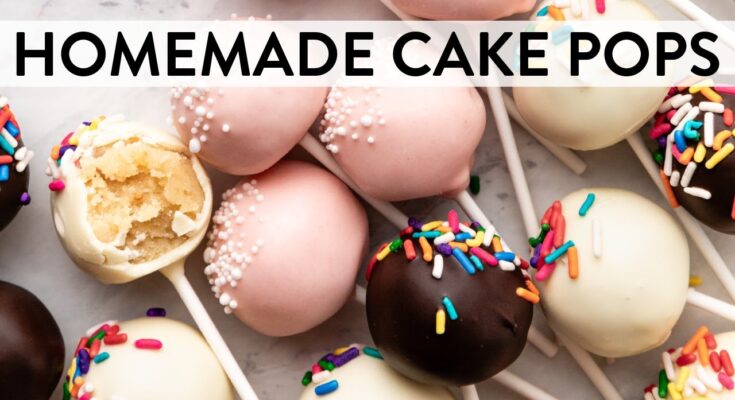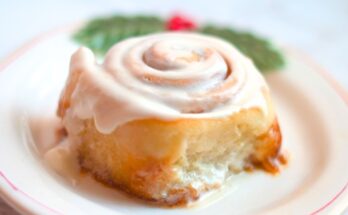Cake Pop Recipe: Cake pops have taken the baking world by storm! These cute, bite-sized treats are essentially tiny cakes on a stick, making them perfect for parties, events, or just a fun kitchen project. Cake pops are beloved not only for their adorable look but also for their delicious taste and endless customization options. Whether you’re aiming for a classic vanilla cake pop or something wild like red velvet or chocolate fudge, the process is straightforward and fun.
Ingredients Needed for Cake Pops
To make the perfect cake pops, you’ll need a few essential ingredients:
Cake Ingredients: You can either use a homemade cake or save time with a box mix.
- 1 box of cake mix (or ingredients to make your own cake from scratch)
- Eggs, oil, and water (per cake mix instructions)
Frosting: This will hold the cake crumbs together.
- 1 cup frosting (buttercream, cream cheese, or store-bought frosting)
Chocolate Coating: For the outer layer of your cake pops.
- 2 cups melting chocolate or candy melts
Optional Decorations: Sprinkles, edible glitter, and colored sugar for extra flair.
Essential Tools and Equipment
To make cake pops, a few tools will make the process easier and more enjoyable:
- Cake pop sticks
- Baking tray
- Mixing bowls
- Parchment paper
- Styrofoam block or cake pop stand (for drying)
- Measuring cups and spoons
- Small spoon or cookie scoop for forming even cake balls
Step 1: Bake the Cake Base
Start by baking a basic cake, as this will be the base for your cake pops. Preheat your oven as per the cake mix instructions or the recipe you’re using.
- Baking Instructions: Mix the ingredients and pour the batter into a greased baking pan.
- Bake until a toothpick inserted in the center comes out clean.
- Let the cake cool completely before moving to the next step.
Step 2: Prepare the Frosting
While the cake is cooling, you can prepare your frosting. You can make a basic buttercream frosting by mixing softened butter with powdered sugar and a splash of vanilla. For a creamier taste, cream cheese frosting also works wonderfully with most cake flavors.
- Simple Buttercream Recipe: Cream 1/2 cup butter with 1-2 cups powdered sugar, adding milk if needed for consistency.
Step 3: Crumble the Cake
Once your cake has cooled, it’s time to crumble! This is a fun step where you’ll break the cake down into tiny crumbs. Use your hands or a fork to crumble the cake evenly.
- Tip: Aim for fine crumbs with no large chunks for a smoother cake pop texture.
Step 4: Mix Cake Crumbs with Frosting
In a large mixing bowl, combine your cake crumbs with the frosting. Start with about half a cup of frosting and gradually add more if needed. You’re aiming for a texture that can be shaped into balls without falling apart or being too sticky.
- Consistency Check: The mixture should hold its shape when squeezed but not feel overly sticky.
Step 5: Forming the Cake Balls
With the cake and frosting mixture ready, begin rolling it into small balls about 1 inch in diameter. Use a cookie scoop or spoon to ensure the balls are of even size.
- Sizing Tip: Each ball should weigh about 1 ounce for a balanced cake pop that’s easy to handle and doesn’t overwhelm the stick.
Step 6: Insert the Sticks
To prepare your cake balls for dipping, it’s time to add the sticks. Melt a small amount of chocolate or candy melts and dip the end of each stick into it before inserting it about halfway into each cake ball.
- Why This Works: The melted chocolate helps “glue” the stick to the cake pop, preventing it from falling off when you dip it later.
- Placement Tip: Place each stick gently into the center of each cake ball without pushing too far to avoid cracking the ball.
Once the sticks are inserted, place the cake pops on a baking tray lined with parchment paper.
Step 7: Chill the Cake Balls
After you’ve added the sticks, chill the cake balls in the refrigerator or freezer to firm them up for dipping.
- Chilling Time: Chill in the refrigerator for at least 1 hour or in the freezer for about 15-20 minutes. Avoid freezing them too long, as this can cause cracking when you dip them in warm chocolate.
Chilling ensures that your cake pops maintain their shape and stay securely attached to the sticks when dipped in the melted chocolate coating.
Step 8: Melt the Coating Chocolate
While your cake pops are chilling, prepare the chocolate coating. You can use candy melts, which come in various colors, or melting chocolate chips.
- Melting Process: Place the chocolate or candy melts in a microwave-safe bowl and melt in 30-second intervals, stirring in between to avoid burning. Continue until the chocolate is smooth and fluid.
- Consistency Tip: If the chocolate seems too thick, add a teaspoon of vegetable oil or coconut oil to thin it for easier dipping.
Melted chocolate should be smooth and just warm enough to coat the cake pops without causing cracks.
Step 9: Dip and Coat the Cake Pops
Once the chocolate is melted and your cake balls are chilled, it’s time to dip! Hold each cake pop by the stick and dip it straight down into the melted chocolate, covering the entire cake ball.
- Coating Technique: Gently tap the stick on the edge of the bowl to let excess chocolate drip off, which helps achieve a smooth, even coating.
- Alternative Coatings: If you’re looking for a different finish, consider rolling the cake pop in crushed nuts, shredded coconut, or cookie crumbs after dipping.
Make sure the coating fully covers the cake ball to help seal in the moisture.
Step 10: Decorate Your Cake Pops
Now comes the fun part—decorating! You can get creative with sprinkles, drizzles, and other toppings to personalize your cake pops. Here are a few ideas:
- Sprinkles: Add colorful sprinkles while the coating is still wet for an easy, festive touch.
- Drizzle Designs: Melt a contrasting color of chocolate and use a spoon or piping bag to drizzle patterns over the coated cake pops.
- Edible Glitter: For a little sparkle, edible glitter or colored sugar can add an extra pop of color and texture.
Decorate each cake pop as desired, and then place it upright in a styrofoam block or cake pop stand to set.
Step 11: Setting and Displaying the Cake Pops
Let the decorated cake pops set completely. If you used candy melts, they should harden quickly at room temperature. For chocolate coatings, you may want to refrigerate the cake pops briefly to ensure a firm coating.
- Display Tips: For a fun presentation, arrange your cake pops in a decorative stand or vase. If it’s a holiday or special occasion, consider theme-specific decorations to match the event.
Whether you’re serving them on a platter or displaying them as a bouquet, cake pops make a visually delightful treat.
Storage and Serving Suggestions
If you don’t plan to eat the cake pops right away, proper storage is key to maintaining freshness:
- Short-Term Storage: Store cake pops at room temperature in an airtight container for up to 2 days.
- Long-Term Storage: For longer storage, keep them in the refrigerator for up to a week or freeze them for up to 2 months.
To serve, let refrigerated cake pops come to room temperature for the best flavor and texture. Frozen cake pops should be thawed in the refrigerator before serving.
Tips for Perfect Cake Pops
Even though cake pops are fun and simple to make, a few tips can help prevent common issues and elevate the final result:
- Don’t Overuse Frosting: Too much frosting can make the cake mixture too soft, causing the pops to fall apart.
- Dip Quickly and Smoothly: For a flawless coating, work quickly and dip each pop in one smooth motion.
- Secure the Sticks: Be sure to dip the stick in melted chocolate before inserting it to create a firm attachment.
With these tips, your cake pops will turn out perfectly every time.
FAQs Cake Pop Recipe
1. Can I use any type of cake for cake pops?
Yes, you can use any flavor of cake, from classic vanilla to red velvet or chocolate fudge. Just make sure the cake is fully cooled before crumbling.
2. Do I have to use sticks for cake pops?
No, you can skip the sticks and make cake balls instead if you prefer. They’ll be just as tasty without the lollipop look.
3. How do I prevent my cake pops from cracking?
Make sure the cake balls aren’t too cold before dipping them in warm chocolate. Letting them sit at room temperature for a few minutes can help prevent cracks.
4. Can I freeze cake pops after making them?
Yes, cake pops freeze well! Store them in an airtight container and thaw them in the refrigerator before serving.
5. What can I do if my coating chocolate is too thick?
Add a small amount of vegetable oil or coconut oil to thin the chocolate, making it easier to dip the cake pops for a smooth coating.
Conclusion
Making cake pops at home can be a rewarding and enjoyable experience, whether you’re preparing them for a celebration or just as a fun kitchen project. This recipe allows for endless creativity, with options for various flavors, colors, and decorations to suit any occasion. With a few simple ingredients and a little patience, you’ll have a batch of beautiful and delicious cake pops ready to share with friends and family.
References
To ensure credibility and provide readers with a deeper understanding of the Cake Pop recipe, we’ve compiled a list of reputable sources. These references offer detailed information, tips, and variations to enhance your cake pop-making experience. For further reading and validation, explore these links:
- Food Network’s Cake Pop Guide – A trusted resource for baking enthusiasts, Food Network offers expert tips on cake pop techniques and flavor combinations. Visit Food Network’s Guide
- Martha Stewart’s Cake Pop Recipe – Known for her meticulous approach to baking, Martha Stewart’s guide to cake pops covers everything from ingredient preparation to presentation. Explore Martha Stewart’s Recipe
- BBC Good Food – Cake Pop Basics – BBC Good Food provides a beginner-friendly approach, making it ideal for those new to cake pop baking. Read BBC Good Food’s Tips
- Tasty’s Creative Cake Pop Ideas – For fun, creative twists on the traditional cake pop, Tasty offers innovative ideas and video tutorials. Check Tasty’s Ideas
These references are perfect for gaining insights and experimenting with different styles and flavors, enriching your cake pop recipe journey.



